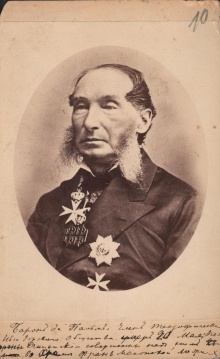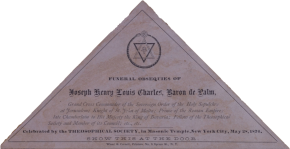Baron de Palm: Difference between revisions
No edit summary |
|||
| Line 21: | Line 21: | ||
</blockquote> | </blockquote> | ||
[[File:De Palm Funeral Ticket.png|right|290px|thumb|Ticket for admission to funeral, from HPB Scrapbook]] | |||
== First cremation in America == | == First cremation in America == | ||
Revision as of 17:53, 4 October 2021
Joseph Henry Louis Charles, Baron de Palm, Grand Cross Commander of the Order of the Holy Sepulchre and Knight of various other orders. He joined the Theosophical Society in its earliest days, and became the first person to be cremated in the United States.
Personal life
Baron de Palm was born at Augsburg, May 10, 1809, in an ancient baronial family of Bavaria.
His father was Colonel and Adjutant-General Baron Johan de Palm, price of the Roman empire, and his mother the Countess Freyen von Seibolsdorf of ThuneFeldt. The Baron de Palm was for a long time in the German diplomatic service, and was also chamberlain to the king of Bavaria. In 1862 he emigrated to America, and spent some time among the Indians of the northwest.[1]
It is likely that the Baron spent some time in Chicago, since he knew Colonel John C. Bundy, publisher of the The Religio-Philosophical Journal and Emma E. Berringer, to whom he bequeathed land.
Theosophical Society involvement
The Baron met Henry Steel Olcott in New York in December, 1875, bringing an introductory letter from the late Col. Bundy, publisher of the The Religio-Philosophical Journal. He was admitted as a member of the new Theosophical Society on March 8, 1876.[2] On March 29, 1876, he was elected on the Council of the Theosophical Society after the resignation of Rev. J. H. Wiggin.
The colonel left this longer account:
Finding him a man of engaging m anners, evidently familiar with the best society, and professing much interest in spiritualism and a wish to learn something about our Oriental theories, I made him welcome, and at his request introduced him to H. P. B. The acquaintance was kept up, the Baron joined our Society and, a vacancy occurring soon after' by the resignation of the Rev. J. H. Wiggin, he was elected a Member of Council on the 29th March 1876. As he complained of feeble health, and of having no one in New York who cared whether he lived or died in the wretched boarding-house where he was put up, I invited him to come and occupy a room in my ‘apartment’, looked after his comfort and called in a physician to prescribe for him. Symptoms of pneumonia and nephritis showing themselves and the medical attendant pronouncing him in danger, he got me to send him Mr. Judge, the Society’s Standing Counsel, and executed a Will devising certain parcels of real-estate at Chicago to two lady friends, making me residuary legatee, and appointing Mr. Newton, Treasurer of the T. S., and myself his Executors, with full powers. Under medical advice and at his own earnest request, he was removed to the Roosevelt Hospital on Friday evening, May 19th (1876) and died the next morning. The result of an autopsy was to show that he had for years been suffering from a complication of diseases of the lungs, kidneys and other organs; a medical certificate that he had died of nephritis was given and filed as prescribed by law in the Health Bureau, and the body was conveyed to the receiving-vault of the Lutheran Cemetery pending the completion of arrangements for interment.[3]
First cremation in America
On May 20, 1876, Baron de Palm died at the Roosevelt Hospital, New York of nephritis, as a result of years of suffering from a complication of diseases of the lungs, kidneys, and other organs. In his will he left 12 parcels of land located in Highland Park, Illinois to Emma E. Berringer of Chicago; all the rest of his estate went to Henry Steel Olcott "in gratitude of his kindness to me." Olcott was also designated as executor.[4]
A symbolic memorial service was held in the Masonic Temple at the corner of 23rd Street and 6th Avenue. The Baron had asked that no clergyman or priest should officiate at his funeral, but that Colonel Olcott should perform the last offices in a fashion that would illustrate the Eastern notions of death and immortality. Col. Olcott wrote in his diary:
The recent agitation of the subject of cremation in Great Britain and America, caused by the incineration of the body of the first Lady Dilke, the scientific experiments of Sir Henry Thompson (vide his published essay The Treatment of the Body of the Death, London, 1874), and the sensational article and pamphlets of Rev. H. R. Haweis upon the unspeakable horrors of the burial-grounds of London, led me to ask him how he would wish me to dispose of his remains. He asked for my opinion upon the relative superiority of the two modes of sepulture, concurred in my preference for cremation, expressed a horror of burial, some lady he had once known having been buried alive, and bade me do as I found most advisable.[5]
The actual cremation did not take place until six months after his death, and the body was preserved by using potter’s clay and Phenol. Finally, on December 6, 1876, the body of the Baron was consigned to the flames, in what constituted the first cremation in America, in the small town of Washington, Washington County, Pennsylvania.
Online resources
- Palm Joseph Henry Louis Charles De at Theosophy World
Articles
- Up in Smoke: Theosophy and the Revival of Cremation at www.wunderkabinett.co.uk
- "A Theosophical Funeral - the Baron De Palm to be Buried According to Egyptian Rites" New York Herald (May 27, 1876), 5.
- Cremation of Baron de Palm by H. S. Olcott
- The Cremation of Baron De Palm at The Bone Idol
Notes
- ↑ De Palm, Joseph Henry Louis, Appletons' Cyclopedia of American Biography, 1600-1889.
- ↑ Membership Register. Theosophical Society Adyar Archives.
- ↑ "Old Diary Leaves Chapter X," The Theosophist 14.4 (January 1893), 194.
- ↑ Record of Wills, 1665-1916; Index to Wills, 1662-1923 (New York County); Author: New York. Surrogate's Court (New York County); Probate Place: New York, New York. Wills Vol 0259-0260, 1878-1879.
- ↑ Henry Steel Olcott, Old Diary Leaves First Series (Adyar, Madras: The Theosophical Publishing House, 1974), 150-151.

